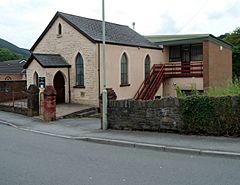Aberfan facts for kids
Quick facts for kids Aberfan |
|
|---|---|
 South entrance to Aberfan in November 2005 |
|
| OS grid reference | SO070002 |
| Community |
|
| Principal area |
|
| Ceremonial county | |
| Country | Wales |
| Sovereign state | United Kingdom |
| Post town | Merthyr Tydfil |
| Postcode district | CF48 |
| Dialling code | 01443 |
| Ambulance | Welsh |
| EU Parliament | Wales |
| UK Parliament |
|
| Welsh Assembly |
|
Aberfan is a village in the Taff Valley in Wales. It is about 4 kilometers (2.5 miles) south of the town of Merthyr Tydfil.
Aberfan is sadly known for a terrible event that happened on October 21, 1966. A huge pile of mining waste, called a colliery spoil tip, collapsed. It slid down the mountain and buried homes and a school. This disaster killed 116 children and 28 adults.
Contents
Geography
Aberfan is located on the side of a valley, near the River Taff. The river flows from north to south through the village. On the western edge of Aberfan, there's an old canal path and a railway line that run next to the river.
History
Aberfan was a very small place with just two houses and an inn for farmers and boatmen. That was until August 23, 1869. On that day, John Nixon and his partners started the Merthyr Vale Coal Mine. This brought many jobs to the area.
By 1966, the village had grown quite a lot, with about 5,000 people living there. Most of them worked in the coal mining industry.
The Aberfan Disaster, 1966
For many years, huge amounts of waste from the coal mine were piled up on the side of Mynydd Merthyr mountain. This mountain was right above Aberfan. These huge piles, called "tips," were made of loose rock and mining dirt.
Some of these tips were built over underground springs. These springs made the ground very wet. Even though people warned about the dangers of piling waste above the village primary school in 1963, these warnings were mostly ignored by the coal company.
On the morning of Friday, October 21, 1966, after many days of heavy rain, a part of tip No. 7 began to move. At 9:15 in the morning, more than 150,000 cubic meters (about 5.3 million cubic feet) of wet waste broke away. It rushed down the mountain very fast.
A huge amount of this waste, over 40,000 cubic meters (about 1.4 million cubic feet), slid into the village. It was like a deep, thick mudslide, about 12 meters (39 feet) deep in some places.
The slide destroyed a farm and 20 houses along Moy Road. It hit the Pantglas Junior School and part of the senior school. Most of these buildings were completely destroyed, and classrooms were filled with thick mud and rubble up to 10 meters (33 feet) deep. Many other houses in the area were flooded, forcing people to leave their homes.
In total, 116 children and 28 adults lost their lives in this terrible disaster.
Aberfan Memorials
Queen Elizabeth II and Prince Philip, Duke of Edinburgh visited Aberfan on October 29, 1966, to show their support.
After the disaster, the mayor of Merthyr quickly started a fund to help the village and the families who had lost loved ones. By January 1967, almost 90,000 people had donated money, totaling over £1.6 million. This money was used to create a memorial garden and a cemetery. It also helped build other facilities to help Aberfan recover.
The Aberfan Cemetery is where many of the victims are buried. The memorial area has been updated over the years. In 2007, the Aberfan Memorial Charity made the garden area even better, replacing old stone with new polished granite. In 2022, the cemetery, memorial garden, and the area of the tip were recognized as very important historical sites in Wales.
The Coventry Playground was built in 1972. It was made with money collected by the people of Coventry. This playground is on the site of the old Merthyr Vale School.
A special memorial garden was opened on the site where the Pantglas Primary School once stood. The Queen helped open this park during her visit to Aberfan in 1974.
The Aberfan Memorial Charity was started in 1989. It is in charge of looking after the cemetery and the memorial garden.
Places of Worship
Bethania Welsh Independent Chapel was built in 1876. After the Aberfan disaster in 1966, this chapel was used as a temporary place where victims were taken for families to identify them. The chapel was later rebuilt in 1970.
Aberfan Calvinistic Methodist chapel was built in 1876. After the disaster, the Queen gave a memorial organ to this chapel. The chapel has faced challenges, including damage from a fire in 2015.
The village also has two smaller chapels. The former Smyrna Baptist Chapel, built in 1877, is now a community center. The Zion Methodist Chapel, built in 1891, is still located on Bridge Street.
Transport
Aberfan is close to the main A470 road. The village has its own train station, Merthyr Vale railway station, which is on the Merthyr line. The Taff Trail, a long path for walking and cycling, also goes through Aberfan. It partly follows the route of the old Glamorganshire Canal.
Education
Aberfan has two primary schools: Ynysowen Primary School and Ysgol Gynradd Gymraeg Rhyd y Grug.
Facilities
- Aberfan & Merthyr Vale Community Centre: This center opened in 1973. It has a swimming pool, a fitness room, a weights room, a café, and a hall.
- Aberfan Cemetery and Aberfan Disaster Memorial: These are important places for remembrance.
See also
 In Spanish: Aberfan para niños
In Spanish: Aberfan para niños





